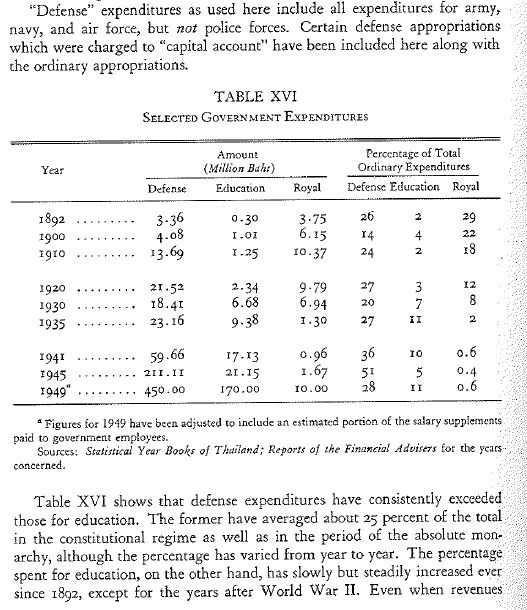Recently I have had cause to revisit some of the classic scholarship on Thai economic history. There are, obviously, many intriguing issues that emerge from these studies — issues that could be the subject of many potentially fruitful New Mandala discussions. But instead of offering a wandering overview, I wanted to hone in on one particular table in one specific book. This is Table XVI (p.192) in James C. Ingram, Economic Change in Thailand: 1850 – 1970, Stanford: Stanford University Press, 1971.
Table XVI is merely one snapshot of some 57-years of Thai economic history, but on each line, at each moment of quantification, I find something thought-provoking. I expect some of you might have a similar reaction.
To state the most obvious point, Ingram’s Table XVI shows, among many other things, that there was a profound shift in royal expenditure as a percentage of the Thai government’s total ordinary expenditure over this period. From 29 per cent of total government expenditure in 1892 it fell to 8 per cent in 1930, and by the end of the Second World War it was consistently well under 1 per cent. That the budget allocation to the palace fell so abruptly between 1930 and 1935 is not so surprising. But what intrigues me is the steep, even abrupt, historical trajectory over the longer term. Before digesting this information I had a general inkling that the palace experienced a sharp decline in its relative fortunes between the height of Rama V’s reign and the beginning of Rama IX’s. But these very stark numbers, and the changes in the relative proportions between defence, education and royal expenditure, were news to me.
By my reckoning, Table XVI should give us one extra reason to ponder the historical dimensions to the issues that we see playing out this decade.
 Facebook
Facebook  Twitter
Twitter  Soundcloud
Soundcloud  Youtube
Youtube  Rss
Rss 